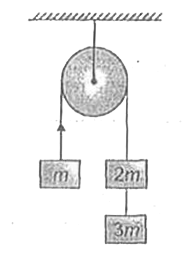
In the given arrangement, mass of the block is M and the surface on which the block is placed is smooth. Assuming all pulleys to be massless and frictionless, strings to be inelastic and light, R1,R2 and R3 to be light supporting rods, then acceleration of point P will be (A is fixed):
0
∞
4Fm
2Fm
The correct Answer is:C

F.B.D of the mass M:
T=F
ma=2T=2F⇒a=2Fm
So, acceleration of point P is 2a=4Fm (from constraint relation)
Similar Questions
Find the relation between acceleration of the two blocks m1andm2. Assume pulleys are massless and frictionless and the strings are inextensible .

View SolutionIn the following arrangement, the system is initially at rest. The 5-kg block is now released. Assuming the pulley and string to be massless and smooth, the acceleration of block C will be

View SolutionIn the arrangement shown in fig. The strings are light and inextensible. The surface over which blocks are placed is smooth. Find:

(a) the acceleration of each block.
(b) the tension in each string.
View SolutionIn the figure given below, with what acceleration does the block of mass m will move? (Pulley and strings are massless and frictionless)

View SolutionIn the arrangement shown in figure, the string are light and intextensible. The surface over which blocks are placed is smooth. Find

(a) the accelrations of the block
(b) the tension in each string.
View SolutionIn the arrangement shown in figure. The strings are light and inextensible. The surface over which block are placed is smooth.Find
(a) the acceleration of each block,
(b) the tension in each string.

View SolutionIn the figure given below , with what acceleration does the block of mass m will move ? ( Pulley and strings are massless and frictionless)

View Solutionfind the acceleration of the block of mass M in the situation shown in figure. All the surfaces are frictionless and the pulleys and the string are light.

View SolutionIn the given figure inclined surface and pulleys are smooth. Strings and pulleys are massless. Acceleration of mass m is :

View SolutionThe acceleration of the block B in fig. Assuming the surfaces and the pulley P1 and P2 are all smooth, is

View Solution
